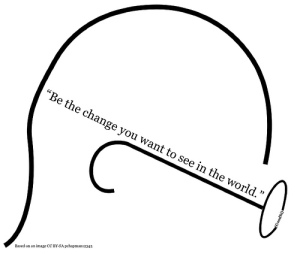As a therapist and mindfulness instructor, I continue to face a dilemma as to whether I bring these two practices together in the therapy room with my clients*. With growing public interest in how mindfulness can help mental and emotional well-being, I am receiving a growing number of enquiries for 1-2-1 mindfulness work to help with life problems. Similarly, there is always a great turnout when I run workshops for therapists on using mindfulness. Both sides of the therapist-client alliance are becoming inspired to bring mindfulness to problems and distress.
It is my opinion that there is great value in an individual having a mindfulness-meditation practice alongside the therapeutic process. I believe they are healthy bedfellows: with therapy bringing insight to the reasons for the struggle, and meditation allowing a compassionate place to process that insight, to learn to ‘be with’ the pain. I would encourage therapists working with clients who have an existing mindfulness practice to use any material the client gathers from their time ‘on the cushion’. However, is it the place of the therapist to introduce the practice, or indeed to be the one teaching meditation to their clients?
 When I teach a course on “Mindfulness for Therapists”, I split the content down in to two parts: The first day-long workshop encourages the use of mindfulness practice to help the therapist do their job better: for instance, helping with self-care, and improving presence for deep listening to the client’s story. It is only in the second part that I begin to discuss the use of meditation for clients. Part 1 is a requisite to attend part 2. Why?
When I teach a course on “Mindfulness for Therapists”, I split the content down in to two parts: The first day-long workshop encourages the use of mindfulness practice to help the therapist do their job better: for instance, helping with self-care, and improving presence for deep listening to the client’s story. It is only in the second part that I begin to discuss the use of meditation for clients. Part 1 is a requisite to attend part 2. Why?
I believe we can only help clients implement this practice if we not only understand the practice theoretically, but that we also have ‘walked the talk’. It would be like a non-swimmer teaching someone to swim: there is a duty of care to keep the novice safe, and that can only come from a deep immersion in the practice.
I trained as a meditation instructor with The Interdependence Project in New York. This was not just an excuse for a year of transatlantic travel! Training with an organisation grounded in secular Buddhism felt like the most ethical approach in deepening my understanding of this ancient practice, and in learning how to teach it. The IDP teacher training programme is a year long immersion consisting of 6, long weekend ‘retreats’ with study / practice blocks in between each retreat block. The Buddhist underpinning provided me with a deep grounding in a range of meditation practices. With IDP, not only did I learn to teach body scans, breath awareness and other mindfulness techniques, we also studied and taught compassion practices and other contemplative practices such as mindful listening and post-meditation inquiry. We also studied the Buddhist philosophy that underpins the practice and were required to evidence our learning by giving Dharma talks and fielding questions from the group we had taught.
I applaud the institutions that are producing mindfulness instructors for the Mindfulness-Based 8 week programmes (such as MBCT and MBSR) in their insistence that to teach meditation, you need to be a practitioner oneself. I believe it is only with a personal practice that one can contact directly some of the experiences a client may face. For instance, in my last post I spoke about the potential pitfalls of meditation – if a therapist doesn’t have a regular and serious practice, how can they help the client navigate such experiences? What is a ‘regular and serious practice’? Well, maybe there are no definitives there – but I doubt one would come up against the ‘darker side’ of meditation if meditating only 10 minutes a day.
I would recommend therapists get a regular practice of at least 30 minutes per day going before considering learning how to teach. And only then, once they have taken a fully certified teacher training course. Doing an 8 week course as a participant is a great start, but ‘doing’ is not the same as ‘teaching’.
An analogy here is considering how many years of clinical training and practice one needs to take to be a therapist. One needs to study, attend lectures and seminars, engage in discussion with fellow therapists in training and ultimately, pass examinations and / or assignments to have a licence to practice. Why would we think meditation teaching should be any different? Meditation is not simply a ‘skill’ to transmit: it is helping a client establish a dialogue with their internal world, and to help the deal with the consequences of that – the good AND the challenging aspects.
Another important consideration is whether teaching a skill to a client disrupts the therapist-client relationship. A recent therapy client of mine thanked me for all I had ‘taught’ him. That compliment had to be side-stepped and then discussed together – the very fact he had regarded himself as ‘student’ to me as ‘teacher’ was impeding his progress – and in his case, highlighting how often he places himself inferior and defers power to others. If I were to teach clients to meditate, does that endanger the “I-Thou”, setting up a hierarchy of knowledge** and giving the impression I know better than my clients?
As useful a companion meditation is to therapy, they ARE different processes: although these can be quite subtle if the therapist comes from a contemplative psychotherapy*** background. As a meditation teacher, I am introducing a practice that helps someone experience their mental activity and not take it too personally. In other words, people are learning to connect with their innate ‘okay-ness’ that exists in between the thinking. In therapy on the other-hand, most of the dialogue in sessions concerns the client’s personal issues, especially on what is causing them distress. One could say meditation focuses on the good of human potential, therapy focuses on the blocks to that human potential. This explains how they can perfectly dove-tail, but could also become confused if applied without care.
A final consideration is understanding when meditation is limited or even dangerous to use in client work. My last blog post introduced some very serious consequences if one’s sense of self is fragile. There are also risks of unpleasant experiences or even setbacks in using meditation with people who may have experienced trauma or are in a state of Post Traumatic Stress Disorder. There are ways that mindfulness can help these groups of people, however, one has to understand the risks of practices that direct attention to parts of the body that form part of a client’s defence to the historical event, or amplify feelings of panic (for example in working with a focus on the chest if following the in and out breath).
So, given the usefulness of meditation, but the pitfalls on therapists being the teacher of the practice, is it ever appropriate to teach clients? And, how else can the therapist support the client? Here are some useful pointers:
- Using the breath to calm and connect with the present moment can be an effective way to bring people back from emotional flooding in a session; Humanistic therapists may also be familiar with the approach of Focusing which encourages the client to develop a “felt sense” of a problem. Ann Weiser Cornell, an expert in this approach, considers meditation and focusing to “go along way down the same path together” – meditation can therefore be a great training aid to becoming familiar with the embodiment of emotional issues.
- Some clients may not be able to attend a group – maybe for geographical meditation resourcesreasons or because they find group work too daunting and need 1-2-1 instruction. Maybe in this case, therapists can introduce some basic principles, or assist a client in using resources produced by meditation instructors available on the internet, CDs, books etc
- As therapists, we can always encourage clients to adopt a wide range of mindfulness practices such as walking, yoga, and paying attention to everyday activities like eating, listening to others.
- To avoid the pitfalls of a ‘dual relationship’, there is always the option of referring a client to a trained teacher.
I hope this has been useful, to therapists and to those people in therapy. I believe if the therapist-client relationship has reached a trusting state of alliance, the very conversation about using mindfulness alongside therapy work becomes a useful dialogue. I also believe that we as therapists need to dialogue more on how we bring ‘tools’ in to our work – and to truly reflect upon the philosophical and ethical reasons for doing so.
I would love to hear your thoughts!
—–
*And indeed, vice versa. Sometimes in group meditation sessions, material gets thrown up that could be processed on a different level depending on which ‘hat’ I choose to wear. Knowing one’s remit in any given situation is critical to keep everyone in the group safe: I think its only right that I try to be helpful to anyone in distress, and indeed I use my therapeutic skillset to do so e.g. empathy, deep listening – but I choose not ‘therapise’ in meditation classes.
**Attempts to remove a similar hierarchy that can distance rather than be helpful is by using the word ‘client’ rather than ‘patient’. The latter, as used in the medical profession, suggests the individual is on the receiving end of a ‘treatment’. Martin Buber’s “I-Thou” speaks to a human-to-human relating, removing the subject-object separation.
***Contemplative psychotherapy is an approach to psychotherapy that includes the use of personal contemplative practices and insights informed by the spiritual tradition of Buddhism. There are psychotherapy training programmes for this approach, but you also come across Buddhists who have trained in more mainstream approaches adapting themselves in to contemplative therapists.

